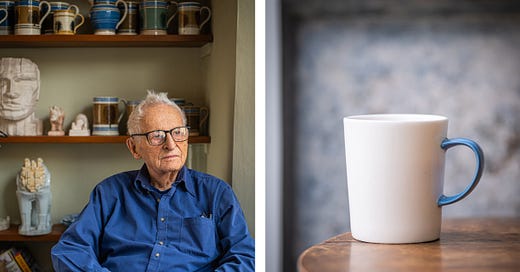A few weeks ago, I was working in the same restaurant room as a young woman sat at a small table, with a laptop computer and a huge water bottle in front of her. The bottle was so large that she couldn’t grip the round of it with just one hand. Built into one side of the bottle was a handle that enabled four fingers to be slipped inside and the container to be grasped. At the top of the bottle sat a screw top the size of a petrol cap with a robust straw built into it, ensuring that one could either glug or sip – be filled up like a petrol tank, or be suckled on a man-made plastic teat. Down the other side of the bottle, a number of measurement ‘notches’ ran from ‘0’ to ‘1.7 litres’ with ‘hydration goals’ printed below each notch – ‘keep drinking’, ‘you’ve got this’, ‘nearly there’. She drank at regular intervals. I had a glass of tap water next to me, which I drank from infrequently: too easily absorbed in my work and too often drinking only when I’m aware that my throat feels dry or, worse still, when my head feels light. I looked at my glass, now empty, and once again towards her bottle, still half-full, and pondered that one of us had chosen convenience over pleasure and the other pleasure over convenience. Advances in all forms of technology have not always made our lives more convenient; merely faster, more powerful, more efficient and so on. Convenience is often compromise – all the water you need for a day to be carried around in one bottle. In a more obvious example, the pre-packaged oven-ready meal can deliver sustenance and gratification without skill, knowledge or effort being required for its cooking. Convenience at the possible expense of flavour, texture or nutrition, not to mention the manifold rewards of cooking. Staying in the kitchen, the microwave and its modern-day heir, the air-fryer, will whir and ping and expect very little from us in return, but we are losing a vital visceral connection to food with each rotation of their mechanical turntables and each clunk into position of their jumbo metal drawers. Phones and watches now allow us to multi-layer one task on top of another – emailing as we conference-call as we walk the dog as we tick off a chunk of our ten thousand daily steps – and we are spread ever more thinly across all of those efforts, frequently failing to do any of them well, failing to enjoy or feel fulfilled by any of them fully, if even partially. We used to navigate online platforms with a sense of fun and adventure, but now drift listlessly to the tune of millionaire Great Directors, Truman-Burbank-like. We adopt a template of what a billion-large digital audience ‘wants to see’ in the hope of remaining relevant, or remaining seen, or, in many cases, simply ‘remaining’; our individuality being reduced daily to one single beating lukewarm algorithm. Words and pictures, once singularly and collaboratively so powerful are now packaged as content: ‘something contained’, spinning more and more like a sad dry supper for one in the dimly lit electrical oven of social media. We sit on the brink of a multitude of world-altering incredible gains from Artificial Intelligence, and yet fail to grasp that what we currently consent to so worryingly, possibly irretrievably, is the delegation of our own thinking. What have we become when the inconvenience of having to think for ourselves becomes too much? How is it that one can belch knowledge but retain nothing of value within the stomach, only more wind? Our habits are changing through the reach and over-reach of convenience, but it was never inevitable that the lives of most were likely to improve because, again, convenience is most often the result of compromise. I have twice had the pleasure of shooting one of this country’s greatest ceramicists, David Queensberry. Following one of those occasions, David presented to me a simple gift: a bone china mug with a blue handle. It’s perhaps one of his company’s best known and most mass-produced pieces of ceramic ware. Touched and a little enchanted by its simple elegance, it took me a couple of weeks to think to drink from it. I made my favourite beverage in the usual way: poured boiling water over a teabag, infused it for three-minutes, stirred in a teaspoon of sugar and a lick of milk to finish. The colour was perfect. I sat at my desk and took a first sip, then a second. Once cooled a little more, I drank down the rest of the mug in three or four large swigs. I got up to make another, enjoying more of the form and feel of the mug this time: easy and light in the hand; smooth and delicate in the mouth, against lip and tongue. Pleasurable, incredibly pleasurable. A vessel to drink from and bring joy, not one to measure intake or be carried around as a 24-hour hydration monitor. Convenience without compromise: the quiet genius of good craft and design.
‘Friday Fragment’ is an additional weekly instalment to my A Thousand Fragments monthly newsletter. (For those who have been kind enough to support my writing with a donation or paid subscription, I have paused that process until mid-July in lieu of several posts still to be published.)





Lovely piece Matt. There is something special about putting thought into the tiny moments of your day - drinking from a lovely mug that sits well in your hand, sipping water from a tall glass you have taken the time to add ice and lime to.
The simple pleasures of life are so easily overlooked in the mindless pursuit of supposed convenience. And to what end really? Another thoughtful piece of writing, Matt.